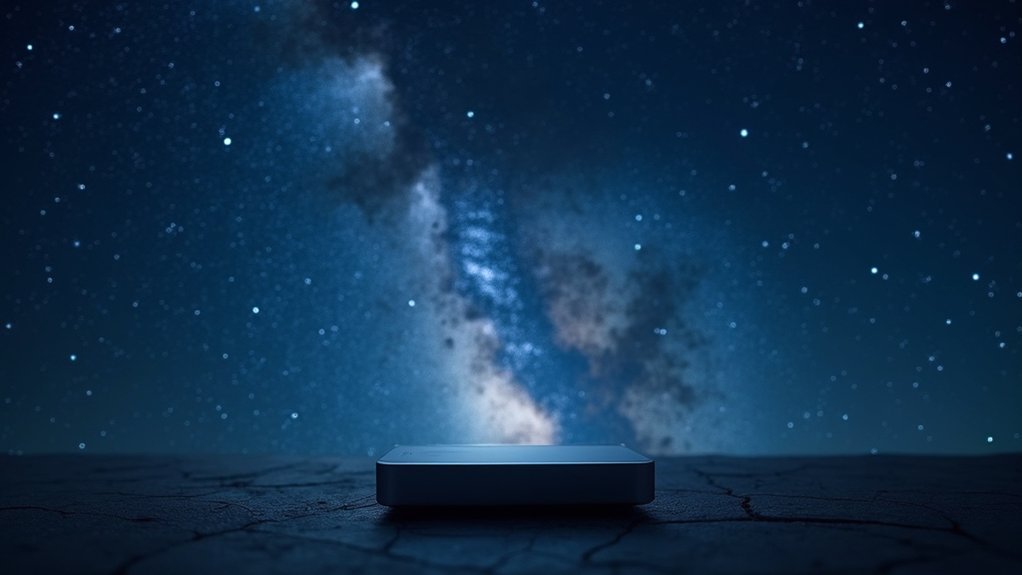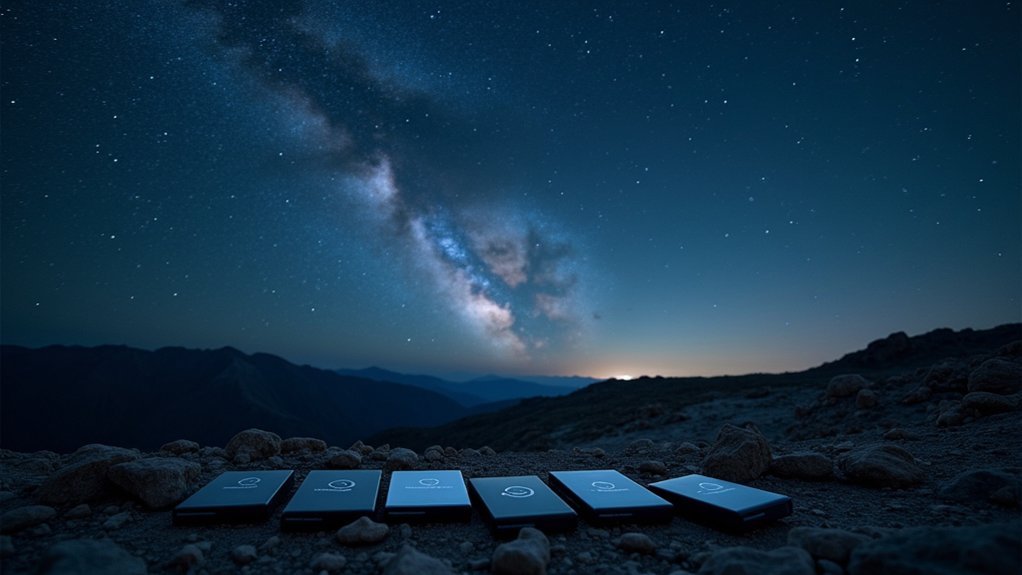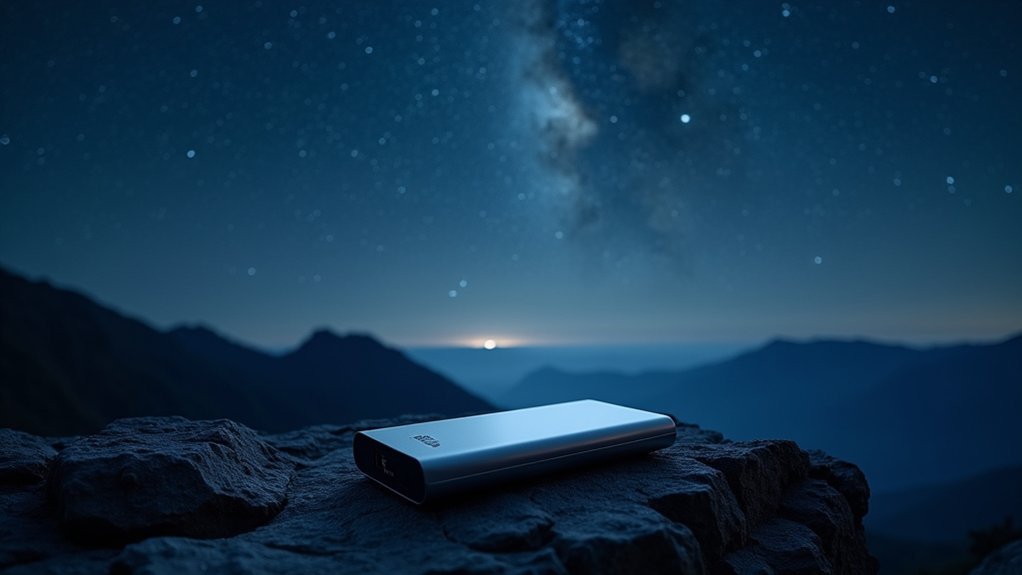For astrophotography, you’ll want a fast, durable SSD like the Samsung T7 Shield (1050MB/s, $149) or LaCie Rugged SSD Pro (6700MB/s) that can handle extreme temperatures (-40°C to 85°C). Their shock resistance and IP65 ratings protect your precious RAW files during field use, while fast transfer speeds prevent dropped frames during critical celestial events. Aim for at least 2TB capacity to store multiple shooting sessions without compromising your cosmic captures.
Why Reliable Storage Matters for Astrophotography

While capturing the cosmos through your lens can be magical, the true value of astrophotography lies in preserving those celestial moments. A single RAW image can consume approximately 30MB, quickly depleting your data storage during extended shooting sessions.
You’ll need reliable storage solutions with substantial capacity—at least 4TB for serious astrophotographers working with multiple exposures. Fast data transfer speeds are critical; SSDs like the Samsung T7 with 1050 MB/s transfer rates let you offload your precious night sky captures efficiently.
Remember that drive failures can be catastrophic. Implement thorough backup strategies using both physical drives and cloud storage to protect your work.
The combination of local SSDs and remote backups ensures you won’t lose hours of painstaking astrophotography to a single point of failure.
SSD vs. HDD: Choosing the Right Drive Type for Night Sky Imaging
When shooting the night sky, your drive’s speed can make or break a session, as SSDs offer transfer rates up to 17 times faster than HDDs for seamless image saving during critical moments.
You’ll find that SSDs maintain better performance in varying temperatures, which matters during those long exposure sessions when drives can heat up or when imaging in cold conditions.
The solid-state construction of SSDs also gives you superior shock resistance when moving your setup between locations, protecting your precious star trail data from bumps that might damage traditional hard drives.
Speed Impacts Image Capture
The success of your astrophotography session often hinges on the speed of your storage device. When capturing celestial objects, you’ll need reliable storage that can handle large files without compromising data integrity.
SSDs excel in this arena, offering transfer speeds up to 7,300 MB/s compared to HDDs’ modest 30-200 MB/s.
- Real-time captures – Faster SSDs allow seamless recording of high-resolution night sky sequences without dropped frames
- Reduced interruption risk – Quicker writing speeds minimize potential data loss during critical moments of celestial events
- Enhanced workflow efficiency – You’ll spend less time waiting and more time shooting when transferring files during sessions
- Immediate field verification – Rapid access to your images lets you confirm successful captures before changing locations
Temperature Tolerance Matters
Beyond speed considerations, temperature tolerance emerges as a significant factor for astrophotographers working in nighttime environments. When you’re capturing celestial objects, your equipment faces temperature challenges that directly impact storage reliability.
SSDs excel in this area, operating effectively between -40°C to 85°C without risk of mechanical failure. Unlike HDDs, they don’t rely on lubricants that can thicken in cold conditions, which often leads to performance issues or complete failure during vital shooting moments.
For night sky imaging sessions that stretch through temperature drops, your SSD maintains consistent read/write speeds regardless of ambient conditions. This resilience guarantees your high-resolution files transfer seamlessly even during extended shoots.
The absence of moving parts makes SSDs inherently more reliable when the temperature fluctuates—a common scenario in astrophotography.
Shock Resistance Benefits
Astrophotographers venturing into remote locations face a vital consideration beyond just storage capacity—physical drive durability.
When you’re capturing celestial wonders, the last thing you need is data loss from a bumped tripod or dropped gear bag.
- SSDs offer superior shock resistance compared to HDDs because they lack moving parts that can fail during transport over rough terrain.
- The LaCie Rugged SSD Pro’s 6,700 MB/s read speeds come with impressive drop protection, safeguarding your night’s work even in challenging conditions.
- Portable SSD options like the lightweight Samsung T7 Shield provide IP65 water/dust resistance ideal for unpredictable outdoor shooting environments.
- The Vital X9 Pro delivers reliable performance at 1,110 MB/s while eliminating the mechanical failure risks inherent to traditional hard drives.
Top Portable Drives for Durability in the Field
When shooting the night sky in remote locations, you’ll need portable drives that can withstand harsh environmental conditions without failing at vital moments.
The LaCie Rugged SSD Pro and Samsung T7 Shield offer outstanding weather resistance with their IP65 ratings, protecting your precious astrophotography data against moisture, dust, and accidental drops.
You’ll find that drives like the OWC Envoy Pro Elektron and Essential X9 Pro provide excellent impact protection through their reinforced exteriors, ensuring your star trail sequences and long-exposure captures remain safe during your adventures.
Durable Drives for Astrophotography
Five essential qualities define the perfect portable drive for astrophotography: durability, speed, capacity, reliability, and weather resistance.
When you’re capturing celestial wonders, you need external hard drives that won’t fail under challenging conditions.
- The LaCie Rugged SSD Pro offers exceptional protection with its IP67 rating and shock-resistant design, making it ideal for remote shooting locations.
- Samsung’s T7 Shield provides IP65 water and dust resistance, perfect for unpredictable weather during nighttime sessions.
- OWC Envoy Pro Elektron’s aluminum chassis withstands extreme temperatures during long exposure nights.
- For budget-conscious photographers, Western Digital My Passport Ultra combines durability with encryption, while SanDisk Extreme delivers high-speed performance at 550 MB/s in a compact form.
Your portable SSD choice can mean the difference between preserved memories and lost data when shooting stars.
Weather-Resistant Storage Solutions
Weather conditions present a significant challenge when capturing the night sky. Your portable hard drive must withstand the elements while maintaining peak performance. Weather-resistant external SSDs offer the protection you need during unpredictable outdoor astrophotography sessions.
| Drive Model | Storage Capacity | Data Transfer Speeds |
|---|---|---|
| Samsung T7 Shield | 2TB | High-speed |
| LaCie Rugged HDD | Up to 5TB | 130 MB/s |
| OWC Envoy Pro | 1TB | High performance |
| Essential X9 Pro | Various options | 1,050 MB/s |
| SanDisk Extreme | Multiple sizes | Fast transfer |
The Samsung T7 Shield’s IP65 rating guarantees protection against dust and water for $149, while the LaCie Rugged HDD offers massive 5TB capacity for large image collections. For ultimate performance, consider the Essential X9 Pro with speeds reaching 1,050 MB/s, guaranteeing you’ll capture every celestial moment without storage concerns.
Impact Protection Features
Capturing the brilliance of shooting stars requires portable drives that can withstand the physical demands of fieldwork. Your storage solutions need robust impact protection to safeguard precious night sky images while you’re traversing rough terrain or setting up in remote locations.
- The LaCie Rugged HDD series withstands drops from up to 1.2 meters, offering essential shock resistance when you’re moving between shooting locations.
- SanDisk Extreme Portable SSD’s rubberized exterior survives 2-meter drops, making it ideal for photographers working in challenging environments.
- The OWC Envoy Pro Elektron SSD features an aluminum housing that protects against impacts while efficiently dissipating heat during extended use.
- For extreme conditions, the LaCie Rugged SSD Pro provides military-grade shock resistance alongside dust resistance, ensuring your astrophotography data remains secure regardless of field conditions.
Speed Requirements for RAW Star Photography Files
When shooting star trails and night skies, you’ll quickly discover that RAW files demand serious transfer speeds from your portable drives. These files can range from 20 MB to 100 MB each, making fast data transfer speeds essential for efficient workflow.
SSDs offer the best performance for astrophotography, delivering read/write speeds up to 3,500 MB/s compared to traditional HDDs’ mere 100-200 MB/s. This difference becomes critical during continuous shooting of high-resolution images.
For transferring files between your camera and external drive, utilize USB 3.1 or Thunderbolt interfaces which provide speeds up to 10 Gbps and 40 Gbps respectively—vastly outperforming USB 2.0’s 480 Mbps limit.
Remember to monitor your SSD’s temperature during extended sessions, as overheating can throttle performance and slow down RAW file processing.
Storage Capacity Planning for Multi-Night Imaging Sessions

Successful multi-night astrophotography demands thoughtful storage planning before you head into the field.
With each RAW image consuming about 30MB, your storage needs can quickly escalate during extended shooting sessions.
- Calculate your required storage space based on shooting habits—500 RAW photos monthly needs approximately 15GB.
- Invest in 1TB to 2TB portable hard drives to accommodate multiple nights of high-resolution star photography.
- Consider using several smaller drives rather than one large drive to better organize data and minimize potential loss.
- Implement robust backup strategies, including cloud storage options, to protect your valuable night sky captures.
Weather-Resistant Options for Outdoor Observation
The unpredictable elements of night sky photography demand more than just ample storage—your equipment must withstand nature’s challenges. Weather-resistant portable drives are essential tools in your astrophotography kit.
The LaCie Rugged SSD and Samsung T7 Shield both offer IP65 ratings, protecting your precious star shots from dust and water exposure. With transfer speeds reaching 1050 MB/s, the T7 Shield allows you to quickly save high-resolution images without missing celestial moments.
For harsh environments, consider the OWC Envoy Pro Elektron SSD with its durable construction or the Vital X8, which functions reliably in temperatures from -40°C to 85°C—perfect for outdoor astrophotography in various climates.
Don’t overlook shock resistance features, which safeguard your data when maneuvering through rough terrain during nighttime shoots or when capturing rare astronomical events.
Power Efficiency: Drives That Won’t Drain Your Field Battery

Battery life becomes a precious commodity during long night sessions photographing meteor showers and celestial events.
Battery power isn’t just a convenience—it’s the lifeline between you and capturing that perfect celestial moment.
When selecting your portable storage, prioritize power efficiency to maximize your shooting time without interruptions.
- Choose SSDs over traditional HDDs—models like the Samsung T7 consume less than 2.5 watts during operation, preserving your valuable battery power.
- Look for drives featuring low power consumption specifications, such as the Essential X6 which delivers 550 MB/s read speeds while maintaining minimal energy draw.
- Opt for devices with USB 3.2 support, which optimize power management during data transfers.
- Always check manufacturer specifications for wattage requirements—lower power consumption equals more time capturing the cosmos.
Backup Strategies for Irreplaceable Celestial Events
Capturing meteor showers and other fleeting celestial phenomena means you’re recording truly one-of-a-kind moments that can’t be recreated if lost.
That’s why robust backup strategies are essential for astrophotographers.
Implement a RAID 1 setup with multiple portable SSDs to mirror your data, providing immediate protection against drive failure during critical shooting sessions.
The SanDisk 2TB Extreme Portable SSD offers both high-capacity storage and durability for outdoor conditions.
Don’t rely solely on physical drives, though.
Combine your portable storage with cloud storage solutions for thorough protection.
Schedule backups immediately after capturing events, before those massive RAW files overwhelm your primary storage.
Remember to regularly check and update your backup approach—your irreplaceable images of rare celestial events deserve nothing less than redundant, foolproof protection.
Budget-Friendly Portable Storage Solutions Under $150

Astrophotography on a budget doesn’t mean compromising on reliable storage options. These affordable portable external storage devices can safeguard your cosmic captures without breaking the bank.
- Samsung T7 Shield 2TB ($149) – This rugged solid-state drive offers IP65 water resistance, perfect protection when you’re shooting in unpredictable night conditions.
- Crucial X6 2TB ($150) – With speeds up to 550 MB/s read, this compact SSD balances performance and value for quick field transfers.
- Western Digital My Passport Ultra 2TB ($100) – An economical option with reliable 121 MB/s read speeds for backing up your night sky images.
- Toshiba Canvio Advance 2TB ($78) – The most budget-friendly option among the best external hard drives, delivering decent 150 MB/s speeds for stargazers watching their spending.
Connecting Your Drive: Interface Options for Different Camera Systems
When venturing into the night to capture celestial wonders, you’ll need reliable connections between your external storage and camera systems. Your choice of interface dramatically affects transfer speeds and workflow efficiency.
Most modern astrophotography cameras support USB 3.0 or higher. For peak performance, match your solid-state drive with your camera’s capabilities. USB 3.1 Gen 1 delivers read speeds up to 5 Gbps, while USB 3.2 Gen 2 doubles that to 10 Gbps—perfect for large image files.
If your camera supports Thunderbolt 3 or 4, you’ll enjoy blazing 40 Gbps transfers, ideal for real-time data handling.
Always check both your camera and drive specifications before purchasing cables—using outdated USB standards like 2.0 (480 Mbps) will create frustrating bottlenecks during those precious night shooting sessions.
Frequently Asked Questions
How Do Portable Drives Perform in Extreme Cold Temperatures?
Portable drives can struggle in extreme cold, potentially slowing down or failing. You’ll want to keep them insulated, use SSD drives when possible, and warm them gradually if they’ve been exposed to freezing temperatures.
Can I Edit Images Directly From the Portable Drive?
You can edit images directly from a portable drive, but it’s not ideal. You’ll experience slower processing speeds compared to your computer’s internal drive, especially with large RAW files from astrophotography.
Which Encryption Features Are Best for Protecting Astrophotography Data?
For protecting astrophotography data, you’ll want hardware-based AES 256-bit encryption with FIPS certification. Drives with built-in fingerprint sensors or PIN pads are ideal since they don’t require software to decrypt your valuable images.
Do Portable Drives Emit Light That Might Interfere With Imaging?
Yes, many portable drives have status LEDs that can emit light. You’ll want to cover these with tape or choose drives with minimal lighting to prevent light pollution during your astrophotography sessions.
How Long Do Portable Drives Typically Last Before Failure?
Portable drives typically last 3-5 years with regular use. You’ll get longer life if you’re careful with them—avoiding drops, extreme temperatures, and safely ejecting before disconnecting. Regular backups are still essential though.
In Summary
You’ll never regret investing in quality storage for your astrophotography adventures. Whether you choose a rugged SSD for harsh environments or a high-capacity HDD for extended shoots, prioritize reliability above all. Remember to back up your celestial captures immediately and select drives that complement your camera system. With the right portable drive by your side, you’re ready to capture the cosmos without worrying about losing those irreplaceable night sky moments.





Leave a Reply